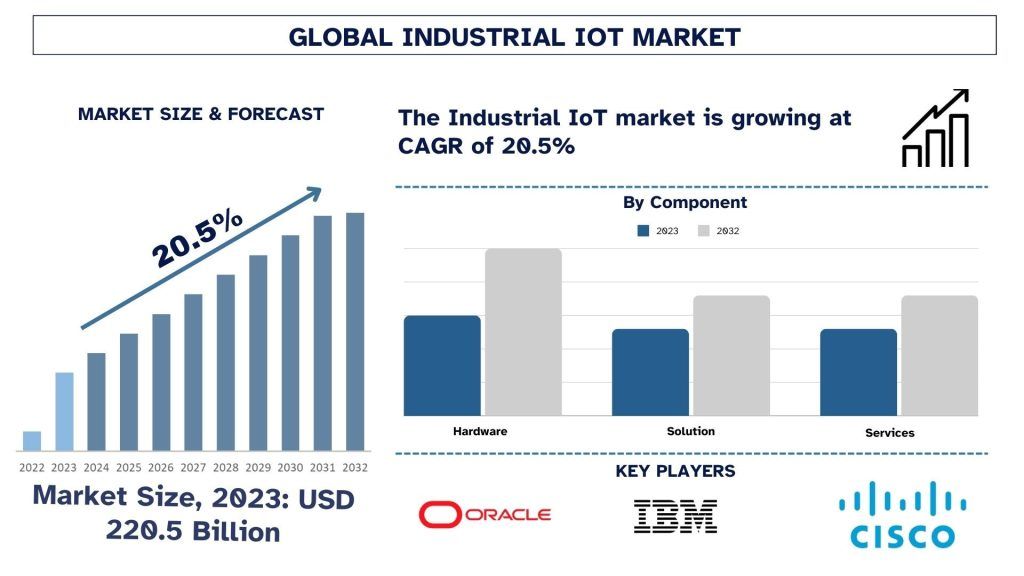- Startseite
- Über uns
- Industrie
- Dienstleistungen
- Lesen
- Kontaktieren Sie uns
Industrial IoT Markt: Aktuelle Analyse und Prognose (2024-2032)
Schwerpunkt auf Komponenten (Hardware, Lösung und Service); Konnektivität (kabelgebunden und kabellos); Endnutzer (Fertigung, Energie & Strom, Gesundheitswesen, Landwirtschaft und Sonstige); und Region/Land
Industrial IoT Marktgröße & Prognose
Der Industrial IoT-Markt wurde im Jahr 2023 auf etwa 220,5 Milliarden USD geschätzt und wird voraussichtlich im Prognosezeitraum (2024-2032) mit einer robusten CAGR von rund 20,5 % wachsen. Das Wachstum des Industrial IoT-Marktes wird durch die steigende Nachfrage nach Automatisierung, Echtzeit-Datenanalyse und verbesserter betrieblicher Effizienz in allen Branchen angetrieben.
Industrial IoT Marktanalyse
Industrial IoT wird als die Verwendung von Aktuatoren und intelligenten Sensoren zur Verbesserung der Fertigung und Produktion sowie zur Verbesserung des industriellen Prozesses definiert. Darüber hinaus wird Industrial IoT oft als Industrie 4.0 oder industrielles Internet bezeichnet und nutzt die Leistungsfähigkeit von Echtzeit-Analysen und intelligenten Maschinen, um effektive und erforderliche Ergebnisse zu liefern. In der letzten Zeit hat das IoT im Industriesektor ein deutliches Wachstum erfahren, da es Ineffizienzen und Probleme in einem frühen Stadium erkennen kann und mehrere Vorteile bietet, wie z. B. Kosten- und Zeiteinsparungen sowie Kontrolle über Qualität und nachhaltige Praktiken. In einem industriellen Umfeld bezieht sich IoT auf die Geräte, die Daten sammeln, überwachen, analysieren und austauschen. Die verbundenen Geräte können Informationen erfassen, erfassen und speichern und die effektive Ausgabe aus den Rohdaten analysieren.
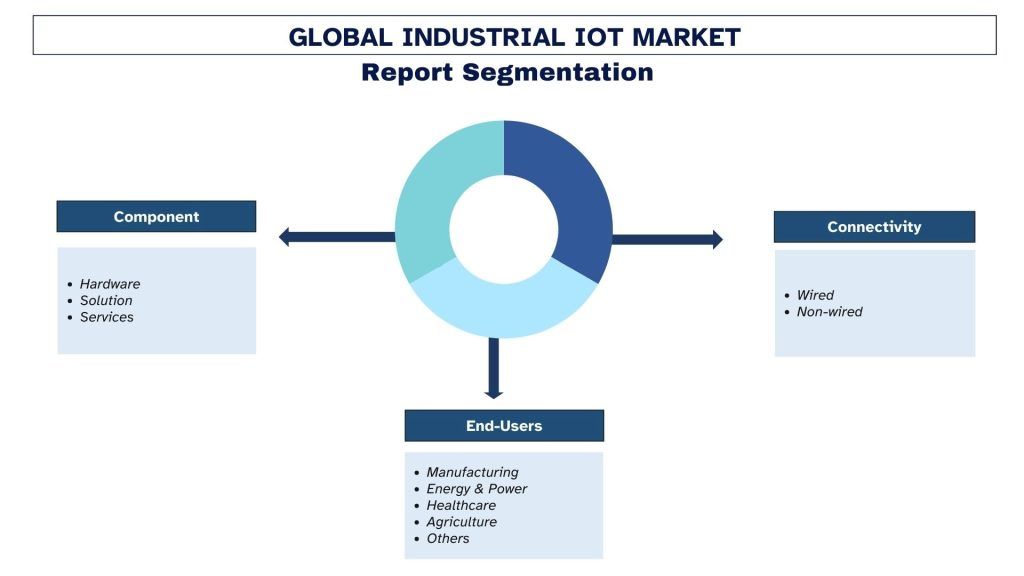
Industrial IoT Markttrends
Dieser Abschnitt erörtert die wichtigsten Markttrends, die die Industrial IoT-Segmente beeinflussen, wie sie von unseren Forschungsexperten identifiziert wurden.
Lösungskomponente transformiert die Industrie
Basierend auf den Komponenten ist der Markt in Hardware, Lösungen und Dienstleistungen unterteilt. Es wird erwartet, dass das Lösungssegment im Prognosezeitraum ein signifikantes Marktwachstum verzeichnen wird, da die Steigerung der Gesamtanlageneffektivität, die verbesserte Effizienz und die Kostensenkung durch einen besseren Zugriff auf die Daten aus Echtzeitlösungen das Wachstum des Lösungssegments unterstützen. Auch die Produktionsprozessplanung, die Optimierung durch die Datenerfassung, die Echtzeitüberwachung und die sensorgenerierte Datenanalyse treiben das Wachstum des Lösungssegments voran. Darüber hinaus macht die Anwendbarkeit des Lösungssegments in verschiedenen Industriezweigen es anspruchsvoller als die anderen. Beispielsweise könnte das Lösungssegment in intelligenten Fabriken, Anlagenüberwachung, Bestandsverwaltung, Maschinenwartung und vorausschauender Wartung usw. eingesetzt werden.
Asien-Pazifik wird einen bedeutenden Anteil am Markt halten
Im Jahr 2023 hielt der asiatisch-pazifische Raum einen bedeutenden Anteil am globalen Industrial IoT-Markt. Dies ist hauptsächlich auf die wachsende Anzahl von Industrien und bessere Konnektivitätsnetzwerke in der Region zurückzuführen. Darüber hinaus dürften die wachsende Bevölkerung zusammen mit den steigenden Ausgaben für Forschung und Entwicklung mit der zunehmenden Anzahl lokaler und internationaler IT-Unternehmen in der Region den Industrial IoT-Markt in der Region unterstützen. Auch die wachsenden Investitionen und die zunehmende Anzahl verschiedener Industriezweige wie Gesundheitswesen, Fertigung und Netzbildung schaffen die Nachfrage nach Industrial IoT in der Region. Darüber hinaus ergreift die Regierung in der Region mehrere Maßnahmen zur Unterstützung von Industrie 4.0. In Indien beispielsweise basiert die Vision der Regierung für Industrie 4.0 auf vier Hauptprinzipien, darunter Informationstransparenz, Vernetzung, dezentrale Entscheidungsfindung und technische Unterstützung.
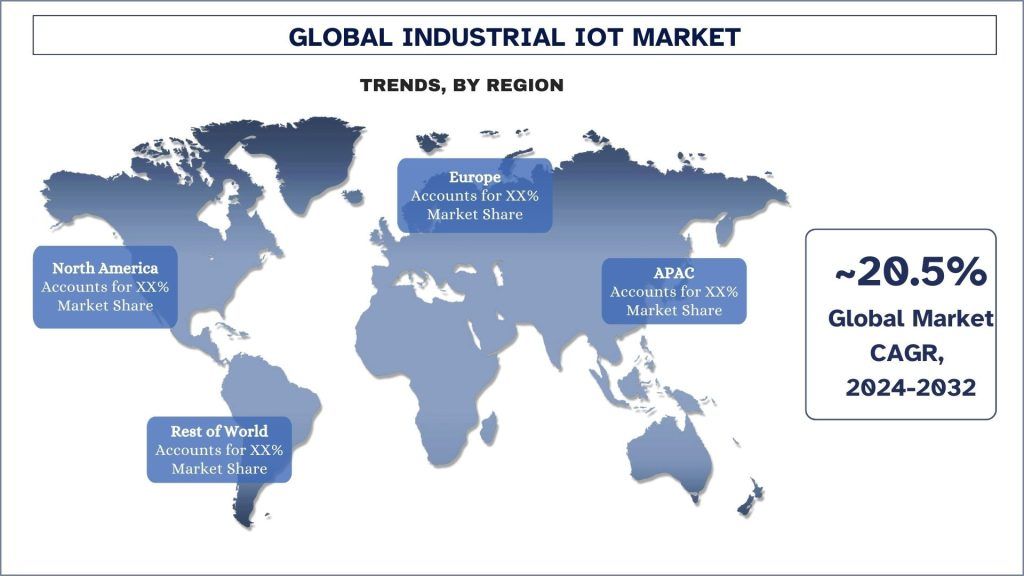
Industrial IoT Branchenüberblick
Industrial IoT ist wettbewerbsfähig, mit mehreren globalen und internationalen Marktteilnehmern. Die wichtigsten Akteure verfolgen unterschiedliche Wachstumsstrategien, um ihre Marktpräsenz zu verbessern, wie z. B. Partnerschaften, Vereinbarungen, Kooperationen, neue Produkteinführungen, geografische Expansionen sowie Fusionen und Übernahmen. Einige der wichtigsten Akteure auf dem Markt sind Oracle, IBM, Cisco System Inc., Microsoft, Rockwell Automation, Energyworx BV, HCL Technologies Limited, Honeywell International Inc., ABB und Siemens. Mehrere M&As sowie Partnerschaften wurden von diesen Akteuren eingegangen, um Kunden mit Hightech- und innovativen Produkten/Technologien zu unterstützen.
Industrial IoT Marktnachrichten
Beispielsweise gab FOSSA Systems, ein Startup, das globale Industrien mit zugänglichen IoT- und Weltraumtechnologien stärkt, im Jahr 2024 bekannt, dass es eine Serie-A-Finanzierungsrunde in Höhe von 6,3 Millionen Euro aufgebracht hat, um seine IoT-Satellitenkonstellation auszubauen, die sich auf das Remote-Asset-Management für industrielle Anwendungsfälle konzentriert. Die Finanzierung wurde von Indico Capital Partners und Nabtesco Technology Ventures gemeinsam geleitet, unter Beteiligung von Newmind Venture und Sabadell Venture Capital.
Industrial IoT Marktbericht Abdeckung
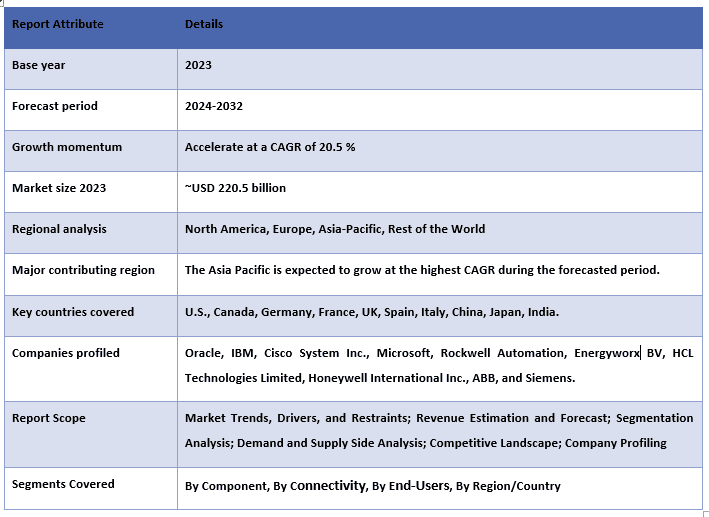
Gründe für den Kauf dieses Berichts:
- Die Studie beinhaltet eine Marktdimensionierungs- und Prognoseanalyse, die von authentifizierten wichtigen Branchenexperten validiert wurde.
- Der Bericht bietet einen schnellen Überblick über die gesamte Branchenleistung auf einen Blick.
- Der Bericht enthält eine eingehende Analyse prominenter Branchenkollegen mit einem primären Fokus auf wichtige Unternehmenskennzahlen, Produktportfolios, Expansionsstrategien und aktuelle Entwicklungen.
- Detaillierte Untersuchung der Treiber, Einschränkungen, wichtigsten Trends und Chancen, die in der Branche vorherrschen.
- Die Studie deckt den Markt umfassend über verschiedene Segmente hinweg ab.
- Tiefgehende regionale Analyse der Branche.
Anpassungsoptionen:
Das globale Industrial IoT kann weiter an die Anforderungen oder jedes andere Marktsegment angepasst werden. Darüber hinaus versteht UMI, dass Sie möglicherweise Ihre eigenen geschäftlichen Anforderungen haben. Nehmen Sie daher gerne Kontakt mit uns auf, um einen Bericht zu erhalten, der Ihren Anforderungen vollständig entspricht.
Inhaltsverzeichnis
Forschungsmethodik für die Marktanalyse des industriellen IoT (2024-2032)
Die Analyse des historischen Marktes, die Schätzung des aktuellen Marktes und die Prognose des zukünftigen Marktes des globalen industriellen IoT-Marktes waren die drei wichtigsten Schritte, die unternommen wurden, um die Akzeptanz von Industrial IoT in wichtigen Regionen weltweit zu schaffen und zu analysieren. Umfassende Sekundärforschung wurde durchgeführt, um die historischen Marktzahlen zu sammeln und die aktuelle Marktgröße zu schätzen. Zweitens wurden zahlreiche Erkenntnisse und Annahmen berücksichtigt, um diese Einsichten zu validieren. Darüber hinaus wurden umfassende Primärinterviews mit Branchenexperten entlang der Wertschöpfungskette des globalen industriellen IoT-Marktes geführt. Nach der Annahme und Validierung der Marktzahlen durch Primärinterviews haben wir einen Top-Down-/Bottom-Up-Ansatz verwendet, um die vollständige Marktgröße zu prognostizieren. Danach wurden Methoden der Marktsegmentierung und Datentriangulation angewendet, um die Marktgröße von Segmenten und Subsegmenten der Branche zu schätzen und zu analysieren. Die detaillierte Methodik wird im Folgenden erläutert:
Analyse der historischen Marktgröße
Schritt 1: Eingehende Untersuchung von Sekundärquellen:
Eine detaillierte Sekundärstudie wurde durchgeführt, um die historische Marktgröße des Industrial IoT-Marktes durch unternehmensinterne Quellen wie Jahresberichte und Finanzberichte, Performance-Präsentationen, Pressemitteilungen usw. und externe Quellen wie Fachzeitschriften, Nachrichten und Artikel, Regierungsveröffentlichungen, Wettbewerberveröffentlichungen, Sektorberichte, Datenbanken von Drittanbietern und andere glaubwürdige Veröffentlichungen zu erhalten.
Schritt 2: Marktsegmentierung:
Nachdem wir die historische Marktgröße von Industrial IoT erhalten hatten, führten wir eine detaillierte Sekundäranalyse durch, um historische Markteinblicke und Anteile für verschiedene Segmente und Subsegmente für wichtige Regionen zu sammeln. Wichtige Segmente sind im Bericht enthalten, wie z. B. Komponenten, Konnektivität, Endnutzer und Region. Weitere Analysen auf Länderebene wurden durchgeführt, um die allgemeine Akzeptanz von Testmodellen in dieser Region zu bewerten.
Schritt 3: Faktorenanalyse:
Nachdem wir die historische Marktgröße verschiedener Segmente und Subsegmente ermittelt hatten, führten wir eine detaillierte Faktorenanalyse durch, um die aktuelle Marktgröße des Industrial IoT-Marktes zu schätzen. Darüber hinaus führten wir eine Faktorenanalyse unter Verwendung abhängiger und unabhängiger Variablen wie Komponenten, Konnektivität, Endnutzer und Industrial IoT-Regionen durch. Es wurde eine gründliche Analyse der Angebots- und Nachfrageszenarien unter Berücksichtigung der wichtigsten Partnerschaften, Fusionen und Übernahmen, der Geschäftsausweitung und der Produkteinführungen im Bereich des industriellen IoT-Marktes weltweit durchgeführt.
Aktuelle Marktgrößenschätzung & Prognose
Aktuelle Marktgrößenbestimmung: Basierend auf den umsetzbaren Erkenntnissen aus den oben genannten drei Schritten haben wir die aktuelle Marktgröße, die wichtigsten Akteure auf dem globalen Industrial IoT-Markt und die Marktanteile der Segmente ermittelt. Alle erforderlichen prozentualen Anteile und Marktaufschlüsselungen wurden anhand des oben genannten sekundären Ansatzes ermittelt und durch Primärinterviews verifiziert.
Schätzung & Prognose: Für die Marktschätzung und -prognose wurden verschiedene Faktoren, darunter Treiber & Trends, Beschränkungen und Chancen für die Interessengruppen, gewichtet. Nach der Analyse dieser Faktoren wurden relevante Prognosetechniken, d. h. der Top-Down-/Bottom-Up-Ansatz, angewendet, um die Marktprognose für 2032 für verschiedene Segmente und Subsegmente in den wichtigsten Märkten weltweit zu erstellen. Die Forschungsmethodik zur Schätzung der Marktgröße umfasst:
Die Marktgröße der Branche in Bezug auf den Umsatz (USD) und die Akzeptanzrate von Industrial IoT in den wichtigsten Märkten im Inland
Alle prozentualen Anteile, Aufteilungen und Aufschlüsselungen von Marktsegmenten und -subsegmenten
Wichtige Akteure im globalen Industrial IoT in Bezug auf die angebotenen Produkte. Auch die von diesen Akteuren angewandten Wachstumsstrategien, um im schnell wachsenden Markt zu konkurrieren
Validierung von Marktgröße und -anteil
Primärforschung: Es wurden ausführliche Interviews mit den wichtigsten Meinungsführern (Key Opinion Leaders, KOLs) geführt, darunter Top Level Executives (CXO/VPs, Vertriebsleiter, Marketingleiter, Betriebsleiter, Regionalleiter, Länderleiter usw.) in allen wichtigen Regionen. Die Ergebnisse der Primärforschung wurden dann zusammengefasst und eine statistische Analyse durchgeführt, um die aufgestellte Hypothese zu beweisen. Die Erkenntnisse aus der Primärforschung wurden mit den Sekundärergebnissen zusammengeführt und verwandelten so Informationen in umsetzbare Erkenntnisse.
Aufteilung der primären Teilnehmer in verschiedenen Regionen
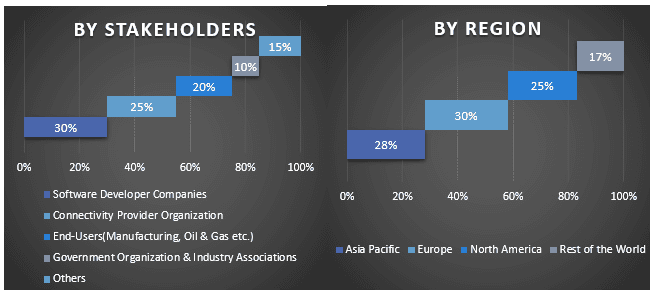
Markt Engineering
Die Datentriangulationstechnik wurde eingesetzt, um die gesamte Marktschätzung abzuschließen und präzise statistische Zahlen für jedes Segment und Subsegment des globalen industriellen IoT zu erhalten. Die Daten wurden in mehrere Segmente und Subsegmente unterteilt, nachdem verschiedene Parameter und Trends in den Komponenten, der Konnektivität, den Endnutzern und den Regionen des globalen Industrial IoT-Marktes untersucht wurden.
Das Hauptziel der Global Industrial IoT Marktstudie
Die aktuellen und zukünftigen Markttrends des globalen industriellen IoT wurden in der Studie genau bestimmt. Investoren können strategische Erkenntnisse gewinnen, um ihre Diskretion für Investitionen auf der Grundlage der in der Studie durchgeführten qualitativen und quantitativen Analyse zu stützen. Aktuelle und zukünftige Markttrends bestimmten die Gesamtattraktivität des Marktes auf regionaler Ebene und bieten dem industriellen Teilnehmer eine Plattform, um den unerschlossenen Markt zu nutzen und von einem First-Mover-Vorteil zu profitieren. Weitere quantitative Ziele der Studien sind:
- Analyse der aktuellen und prognostizierten Marktgröße des Industrial IoT-Marktes in Bezug auf den Wert (USD). Analysieren Sie auch die aktuelle und prognostizierte Marktgröße verschiedener Segmente und Subsegmente.
- Die Segmente in der Studie umfassen die Bereiche Komponente, Konnektivität, Endnutzer und Regionen.
- Definieren und analysieren Sie den regulatorischen Rahmen für das Industrial IoT
- Analysieren Sie die Wertschöpfungskette unter Einbeziehung verschiedener Intermediäre sowie die Analyse des Kunden- und Wettbewerberverhaltens der Branche.
- Analysieren Sie die aktuelle und prognostizierte Marktgröße des Industrial IoT-Marktes für die wichtigsten Regionen.
- Zu den wichtigsten Ländern der in dem Bericht untersuchten Regionen gehören der asiatisch-pazifische Raum, Europa, Nordamerika und der Rest der Welt
- Unternehmensprofile des Industrial IoT-Marktes und die von den Marktteilnehmern angewandten Wachstumsstrategien, um sich in dem schnell wachsenden Markt zu behaupten.
- Eingehende regionale Analyse der Branche
Häufig gestellte Fragen FAQs
F1: Wie groß ist der globale Markt für Industrial IoT derzeit und welches Wachstumspotenzial hat er?
F2: Was sind die treibenden Faktoren für das Wachstum des globalen Industrial IoT?
F3: Welches Segment hat den größten Anteil am globalen Industrial IoT nach Komponente?
F4: Welche neuen Technologien und Trends gibt es im globalen Industrial IoT?
F5: Welche Region wird das globale industrielle IoT dominieren?
Verwandt Berichte
Kunden, die diesen Artikel gekauft haben, kauften auch

